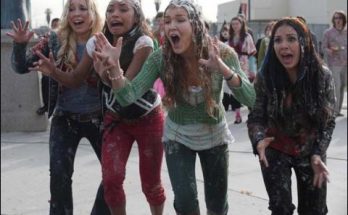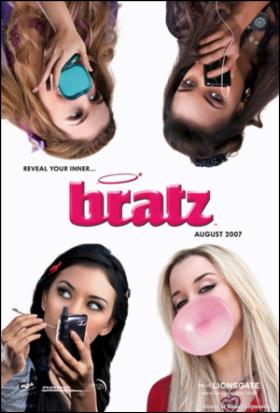The entire filming of BRATZ took place in the Los Angeles area during the months of February and March, 2007. Real city locations were used ranging from the Santee Educational Complex located in South Los Angeles, to The Grove, a trendy shopping center in the heart of West Hollywood, and finally moving over to the residential neighborhood of Studio City.
The 30-day schedule had its challenges even though the cast and crew were happy to be working in their own backyard. “Los Angeles is a very expensive place to film nowadays,” recounts production designer Rusty Smith. “We didn’t have a big budget and we were trying to do something quite spectacular. We definitely had our work cut out.”
Much of the story takes place with the BRATZ attending high school and the location that doubled for Carry Nation High was the Santee Educational Complex, which opened its doors in 2005 serving approximately 3,479 students, grades 9 through 12. The school was transformed into the fictional Carry Nation High for 3 ½ weeks while regular school was in session.
Overtaking the school courtyard, a 16’ high statue of the legendary Carry Nation, the most infamous and formidable member of the Women’s Christian Temperance Union in pre-prohibition America, was erected, wielding her hatchet in one hand and bible in the other.
Shooting in between school bells and dealing with thousands of students emptying out into the corridors definitely lent a blast of authenticity to the realities of high school life. The experience was not lost on the cast says Chelsea Staub, who one can say played the incarnation of Carry Nation herself, a student who rules the school with an iron fist.
“Filming at a high school really helped me step into ‘Meredith’s’ shoes,” says Chelsea. “All the sounds and background images helped make it real for me. The shifting echoes of students on the bleachers and school bells that released the chaos of kids changing classes made me feel like I was truly a part of the high school experience as opposed to doing a scene on a soundstage.”
From a production standpoint, Smith explains working around the logistics of school being in session was well worth the effort.
“The presence of that school and the way it’s laid out, almost like a prison, became a major character in the film,” says Smith. “Sean was adamant about using this school. We knew it was going to be complicated and it was but we pulled it off. I’m sure it was a big distraction for us to be there and it’s really a compliment to the principal and the students’ cooperation because we couldn’t have done it without them.”
“I was amazed at how orderly and respectful the students at Santee High were during our invasion,” says Chelsea. “I know I would have had issues walking by our heavenly omelet station every morning.” As a real life senior, Logan Browning also felt the effects of life imitating art. “Filming at a real high school was interesting because you could see real cliques and compare them to the simulated cliques in the movie. I enjoyed filming at Santee High because I left my own high school to film BRATZ and I missed being at school and being around other kids. I also think it was really cool that some of the students got to be extras in the film,” says Logan.
“We had a pretty serious mandate from the producers to make these girls hip but to keep them real, make them accessible to young girls,” says Smith. “ I’d say that the film is really about having a passion for self-expression. I really wanted to make each of the girls’ bedrooms so vibrant with color and visually different from each other and that really played well against the background of Carry Nation High. The school is so devoid of color, it’s all in muted shades of gray and it was a world that because of the way the Principal ran it, it felt more like a prison. The BRATZ bring color and fun to the school which became a sort of metaphor for the story.”
Drawing from his background of working in theatre, Smith found that the production became more about approaching set design with the same logistics used in staging plays than in shooting a film.
Smith says, “When you’re designing musical sets and creating theatrical venues like we needed for our three big musical productions, all of a sudden you’re dealing with moving lights, grids, lighting trusses and a whole bunch of techical equipment that you have to think about. Sean was very clear on how he wanted those scenes to feel and read, how over-the-top and how to walk that line of fantasy/reality. The sets couldn’t overshadow or distract from showcasing the actors’ talents.”
Adding to the equation of trying to deliver big production values on a limited budget also came the fact that two of the main cast and many of the extras were minors, therefore under strict child welfare laws governing how many hours they could be in front of the camera.
Producer Steven Paul explains the dynamics of working with kids. “We are so blessed to have Sean McNamara directing this film,” Paul says. “He’s worked with lots of young kids before, and also stories that involve dancing and singing so he understands this world incredibly well. It is always challenging because it’s not easy when you’re working with some kids who are underage and only have a certain amount of hours a day to be on camera — you’re working with a lot of kids, with dancing, singing, and tons of wardrobe. Sean got so much thrown to him that many filmmakers would have pulled their hair out but Sean is the most even-tempered, optimistic and enthusiastic person that I’ve ever seen — nothing throws him off.”
Hits: 105



